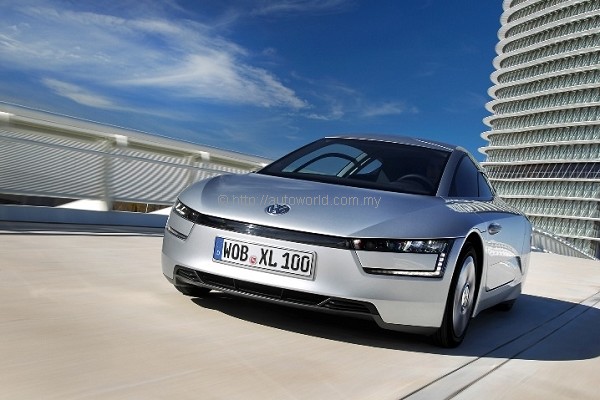Volkswagen XL1 – World’s Most Fuel-Efficient Production Car
Wolfsburg, 21 February 2013. – At a fuel consumption rate of 0.9 litre per 100 kilometres, the Volkswagen XL1 is the world’s most fuel-efficient production car. Built as a two-seater plug-in hybrid, the XL1 can cover up to 50 kilometres in all-electric mode with zero emissions. As a plug-in hybride, a car user can plug it in to charge overnight, and run the first 50 kilometres without using any fuel at all, and when the batteries run out, the engine and hybrid system take over.
Theoretically, if one travels less than 50 kilometres a day, one can get by without using any fuel at all. This brings us to the question of whether it is better just to buy an electric car – well, for people who have to travel more than 50 kilometres a day, and also want the flexibility of going anywhere else where there is no infrastructure for a re-charge, the plug-in hybrid is the answer. Having driven an electric car for a while, the problem I face is the fear of running out of battery power, so a plug-in hybrid makes sense.
The XL1 is an automotive hero that follows pure sports car design principles: low weight (795 kg), perfect aerodynamics (Cd 0.189) and a low centre of gravity (1,153 mm high). This gives the efficient Volkswagen the ability to cruise on the road at a constant speed of 100 km/h using just 6.2 kW / 8.4 PS. In all-electric mode, the XL1 requires less than 0.1 kWh to cover a driving distance of over one kilometer.
High-tech lightweight design, perfect aerodynamics and a plug-in hybrid system – consisting of a two-cylinder TDI engine (35 kW / 48 PS), Emotor (20 kW / 27 PS), 7-speed dual clutch gearbox (DSG) and lithium-ion battery – all make it possible for the new Volkswagen XL1 to emit just 21 g/km of CO2. If necessary, the XL1, with a top speed of 160 km/h, can accelerate to 100 km/h in just 12.7 seconds. Clearly, 0.9 l/100 km fuel consumption is a record figure that has not been achieved by any other vehicle to date, and it illustrates how Volkswagen is redefining what is technically feasible in the automotive industry.
Conceptually, the XL1 represents the third evolutionary stage of Volkswagen’s 1-litre car strategy. When the new millennium was ushered in, Prof. Dr. Ferdinand Piëch, who is today Chairman of the Supervisory Board of Volkswagen AG, formulated the visionary goal of bringing to market a production car that was practical in everyday use with fuel consumption of one litre per 100 km. In the two-seat XL1, this vision has become reality.
Despite the tremendous efficiency of the XL1, developers successfully came up with a body concept, which delivers more everyday utility than in the two previous prototypes. While the driver and passenger sat in a tandem arrangement for optimal aerodynamics in the L1, the 1-litre car presented in 2002 and in 2009, in the XL1 two occupants sit slightly offset, side by side, nearly as in a conventional vehicle.
The XL1 is 3,888 mm long, 1,665 mm wide and just 1,153 mm tall. By usual automotive standards these are extreme dimensions. For comparison: a Polo has a similar length (3,970 mm) and width (1,682mm) but is significantly taller (1,462 mm). Even a purebred sports car like today’s Porsche Boxster is 129 mm taller (1,282 mm). So, the XL1 will make a spectacular appearance – a car of the future, built for today.

























